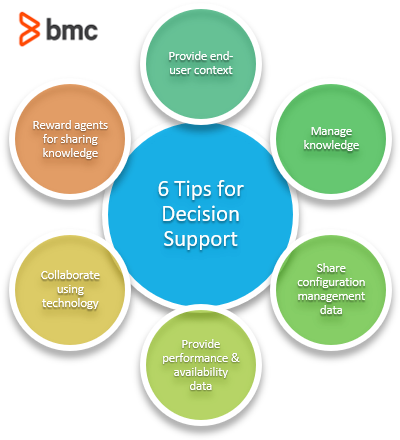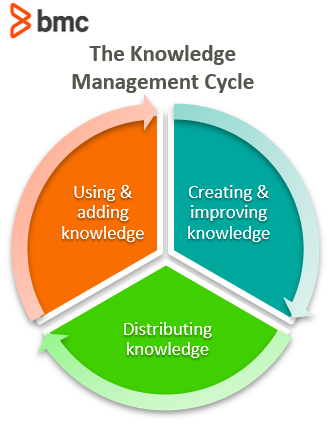Isn’t it great when you phone the service desk and get the best agent on the phone, the one you know will fix your problem instantly, day or night? It’s always good to get the IT hero on your case. The hero is that person who knows exactly how everything works and how to troubleshoot anything. For their ability to get users back up and running fast, heroes are beloved by the business and the users alike.
The problem with this scenario is that the hero model doesn’t scale. What happens when the hero in your IT department is sick or takes a well-deserved vacation? Chances are that, in this type of culture, you’ll see:
- Service levels drop
- Dissatisfaction increase
- Users putting off calling the service desk until their favorite agent is back on deck
If this sounds familiar, then you have work to do—that’s where decision support comes in. In this article, I want to share with you five simple ideas that can help your service desk agents:
- Make the right decisions quickly
- Deliver better service
In turn, these improvements will also increase overall staff retention and productivity.
What is decision support?
Every member of your team needs to be able to deliver the same heroic level of support to your customers, every time. The way to do this is to ensure that everyone has access to the appropriate knowledge and decision support tools. Such tooling will improve consistency and quality in your incident management practice, particularly in an ITIL® environment.
When you consider how decision support can help even the playing field for your service desk, think about these criteria:
- Relevance. Will this information actually help the agent get the incident to the next step, or is it just a distraction?
- Presentation. Are we presenting the information in a useful, actionable way? Or is it too complex or flashy to actually help your agents?
- Timeliness. Is this the right information, at the right time, to the further the process?
Now, let’s look at my six tips for improving decision support for your service desk agents.

1. Provide end-user context
Technology now gives you all the tools you need to capture information about the user, their location, and other relevant information related to the incident they are reporting.
This means that the agent does not have to waste valuable time gathering this background information. Instead, an agent can get straight to work troubleshooting and resolving the issue, getting the customer back to work faster—and with much less frustration.
If you’re not already using technology that captures these needed details, invest in a solution quickly.
2. Manage the knowledge
In the bad old days of the hero culture, information was treated as currency. Information was the critical value the hero brought to the organization, and it was what kept the hero’s job safe—no one had as much knowledge as they did.
Knowledge management is now smarter and more accessible. It is a must for any organization today. Information is easier to populate and maintain. This means that service desk staff can ramp up much faster. Integration between your knowledgebase and service desk tool will immediately suggest appropriate solutions to common issues.

Your hero can now go off to lunch or on vacation without leaving a massive knowledge hole in their wake.
3. Share configuration management data
Make any service desk agent a hero by providing them a simple, graphical view of:
- Your services, both in your current service catalog and your overall service portfolio
- The key configuration items
- Relationships and dependencies
This interactive, visual representation of the technology your agents support allows them to:
- Drill down easily in order to diagnose issues
- See the real or potential impact a failure can have on the business
This means your agents can accurately prioritize incidents—so the right teams can immediately begin working to fix the issue.
4. Provide performance and availability data
The integration of system monitoring solutions into service desk tools allows the service desk to see exactly what has failed and, in some cases, what is about to fail.
This can mean that they can prevent a failure before it impacts business users—or at the very least, warn them of an impending outage. This type of diagnostic tooling is critical for effective service management.
5. Collaborate using technology
It is not always easy to collaborate when working in a busy, large, or distributed service desk environment. Using modern tools to collaborate and share information digitally needs to be a standard part of working practice, no matter where agents are located. Collaboration can:
- Help resolve issues faster
- Create and foster a sense of team and belonging.
This team spirit can be the real catalyst for service improvement—I would argue more so than any technologies we provide.
6. Reward agents for sharing knowledge
A culture where heroes thrive is not a healthy one. When heroes are rewarded, knowledge hoarding is encouraged and becomes accepted behavior. This creates an atmosphere of competition, not collaboration, that will have a negative impact on business productivity.
Rather than rewarding agents for solving issues, start rewarding them for sharing knowledge.
Heroes are an unacceptable risk to the organization. If you are ever sitting at your desk thinking “I hope John doesn’t get hit by a bus tomorrow”, you need to understand that John is not an asset—he is a liability. You need to start building a program of knowledge sharing right now.
Additional resources
For more on this topic, explore these resources:






